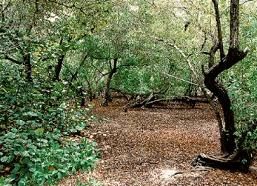VEGETATION
From the Latin vegetatio , the term vegetation is used to name the group of plants that exist in a certain geographic space. It can be the flora of the land ( native vegetation ) or imported species.

The notion of vegetation does not mention any specific taxon. In other words, the vegetation can be composed of plants with different characteristics and in very varied geographical situations.
The concept allows to name from virgin forests to wild shrub assemblages or gardens designed by a landscaper. For example: "The vegetation of this province is exuberant" , "I want to go on vacation to a place where there is a lot of vegetation and animals" , "Pollution makes the vegetation of these types of cities increasingly scarce" .
It is important to note that vegetation is not only important from a landscape or visual appeal point of view, but is also vital for oxygen generation , soil conservation and the so-called carbon cycle.
There are different types of vegetation depending on the environment in which it is found. The aquatic vegetation is one that adapts to the water or environments with a high humidity. These plants live in ponds, swamps, deltas, or lagoons, either fully submerged or with floating leaves.
Other types of vegetation are gipsophilic vegetation (which appears in chalky soils) and halophilic vegetation (typical of soils with a high salt index).
Vegetations in the adenoids
 They are called vegetations in the adenoids and other glands of the lymphatic system that are intended to protect the body from childhood infections and are located in the back of the nose, between what is commonly known as the bell and the palate . The adenoid vegetation , is a medical concept that refers to the excessive development of the tonsils and lymph follicles.
They are called vegetations in the adenoids and other glands of the lymphatic system that are intended to protect the body from childhood infections and are located in the back of the nose, between what is commonly known as the bell and the palate . The adenoid vegetation , is a medical concept that refers to the excessive development of the tonsils and lymph follicles.
As the child grows these glands increase in size (up to four years of age); then their size begins to decrease until they disappear completely. When an infection occurs in the vegetations, that is, they become inflamed, the respiratory and auditory tracts are blocked ; this is due to its location.
The main symptoms when the vegetations become inflamed are obstruction of the nasal passages that in some cases leads to sinusitis, a deep voice, snoring and abundant mucus. It can also be accompanied by intense earaches and even suppuration.
The consequences of this infection can be deformations in the palate which makes it difficult, which brings complications in the teething process (because the child cannot breathe properly through the nose and begins to breathe through the mouth), bad breath (due to breathing through the mouth), respiratory arrest or obstructive apnea (due to the exaggerated enlargement of the tonsils), otitis (and if they recur over a long period of time, it could cause perforation in the eardrum and other types of malformations).
In order for this infection to be diagnosed, it is necessary for the doctor to palpate the children and perform an X-ray that allows them to know exactly what the problem is. Once the diagnosis is made, a treatment with a medication is recommended whose objective is to decrease until the vegetations are completely eliminated.
In some cases, surgery is also used to end this problem . This occurs when the obstruction of the nose is absolute, the patient suffers from deep bouts of catarrh, regular suppuration in the ears or bronchitis. In this case, it is strictly necessary that both the child and their families follow the surgeon's instructions in order for the recovery to be complete.
Comments
Post a Comment